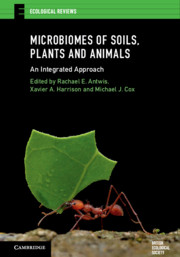Book contents
- Microbiomes of Soils, Plants and Animals
- Ecological Reviews
- Microbiomes of Soils, Plants and Animals
- Copyright page
- Contents
- Contributors
- Preface
- Abbreviations
- Chapter One Microbiomes of soils, plants and animals: an introduction
- Chapter Two Analytical approaches for microbiome research
- Chapter Three Microbiomes of soils
- Chapter Four Factors that shape the host microbiome
- Chapter Five Microbial symbioses and host nutrition
- Chapter Six The microbiome and host behaviour
- Chapter Seven Host microbiomes and disease
- Chapter Eight Adapting to environmental change
- Chapter Nine Microbial biotechnology
- Chapter Ten Synthesis and future directions
- Index
- Plate Section (PDF Only)
- References
Chapter Eight - Adapting to environmental change
Published online by Cambridge University Press: 07 March 2020
- Microbiomes of Soils, Plants and Animals
- Ecological Reviews
- Microbiomes of Soils, Plants and Animals
- Copyright page
- Contents
- Contributors
- Preface
- Abbreviations
- Chapter One Microbiomes of soils, plants and animals: an introduction
- Chapter Two Analytical approaches for microbiome research
- Chapter Three Microbiomes of soils
- Chapter Four Factors that shape the host microbiome
- Chapter Five Microbial symbioses and host nutrition
- Chapter Six The microbiome and host behaviour
- Chapter Seven Host microbiomes and disease
- Chapter Eight Adapting to environmental change
- Chapter Nine Microbial biotechnology
- Chapter Ten Synthesis and future directions
- Index
- Plate Section (PDF Only)
- References
Summary
Unprecedented climate change, pollutants and habitat alterations are causing abiotic stress across all plants and animals. Global increases in temperature, as well as decreases in pH in the ocean, have already caused microbiome dysbiosis in a range of species, and previously commensal microbes have turned pathogenic in response to extreme environmental conditions. This will have far-reaching consequences for host survival and associated ecosystem functions. However, host microbiomes may actually be the key to buffering these unprecedented environmental changes. The host microbiome contains massive genetic potential, and their vast numbers, high turnover, wide metabolic scope and short generation times may afford opportunities for faster acclimatisation and adaptation. Examples of this already exist, although responses are likely to be highly context-dependent. It is becoming increasingly clear that preservation of the microbiome is likely to be the key to maintaining healthy ecosystems in an uncertain future. However, there are still large knowledge gaps in almost every area, which need to be urgently addressed so we can apply conservation efforts in a judicious manner.
Keywords
- Type
- Chapter
- Information
- Microbiomes of Soils, Plants and AnimalsAn Integrated Approach, pp. 154 - 181Publisher: Cambridge University PressPrint publication year: 2020
References
- 1
- Cited by



